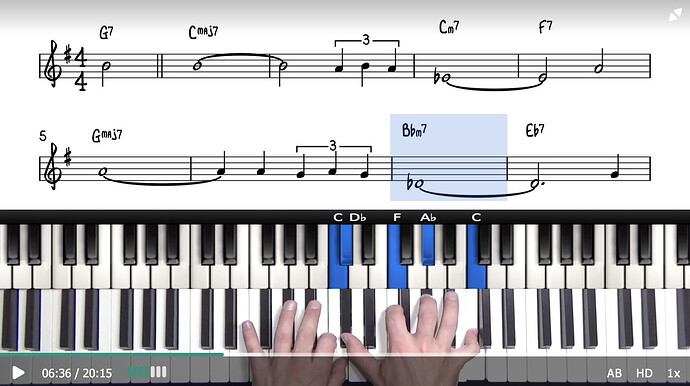I would like to do block chords on the first measure of the bridge of In a Sentimental Mood. It has a Dbmaj 7 with C on top going to a Bbm7. How should I treat the Dbmaj chord? The examples I have seen discuss minor and dominant chords, but not sure how I should consider the major chord. I am sure that I have probably missed something!
Hey Celia ![]()
Great question!
I have made an 4-minute explainer video for you as it’s much easier to explain with a visual demonstration:
To Summarise:
-
Take the melody note, double it at the top and bottom, and then add the chord tones in between
-
When the melody note changes, you can often keep the middle of the chord structure down, and just move the top and bottom note
-
You can create rootless structures, like the example over “Bb-7” which in fact I am visualising as Dbmaj7 with the 9th on the top and the bottom.
-
It’s important to recognise here that Dbmaj7 and Bb-7 are relative major and minor keys, and so the same chord structures can be used over both chords as demonstrated.
-
Flicking up into the lowest note is also nice thing to do to add more character to block chords.
Let me know if that answers your question and happy to continue the discussion below ![]()
You might notice the new piano sound we are using… it has a much richer and warmer sound than the last one.
I’ve almost finished arranging “Someone To Watch Over Me” and “When Sunny Gets Blue” and can’t wait to record my first jazz standard lessons with this new piano sound.
Cheers!
Hayden,
Thank you so much! I am so glad you made a video. It makes perfect sense. I was unclear about putting the Db right below the C…but it sounds great. It is good to know that I can apply the same logic to major chords. I also need to pay attention to the relative minor! I am starting to like block chords and they really sound good going into the bridge of that song. I can’t wait to work on it.
Look forward to hearing and seeing the new lessons! Those are two of my favorite tunes. You are a terrific instructor!
My pleasure Celia.
And yes it’s that half step interval which gives the block chords a nice dissonant ‘crunch’ at the bottom.
Yes it’s a useful way to think because it gives you a nice shortcut where you can apply the same voicings to different situations.
For example, you could use that same Dbmaj7 block chord voicing (C-Db-F-Ab-C) over any Bb-7 and it will sound great.
I used something similar as a fill in this lesson on “Just Friends”.
Start from 6m 30s in the lesson and you will see this:
Here I am using it as a a fill over the 25 progression Bb-7 to Eb7 - so a very different application, but the exact same voicing. Notice that the root is missing (Bb) but we still have the ‘essential chord tones’ Db and Ab which is the b3 and b7 of Bb-7.
In this example, the melody is static (see the tied whole note) and so I want to add some interest. This is an excellent time to use block chords in my opinion… They are great to fill in space when the melody, harmony, or both, is static.
So I think of that shape as both Dmaj7 and Bb-7 - and that way, I get twice as much mileage out of that same voicing.
Hope that makes sense!
Yes they are such a beautifully happy and cheery sound… I’m a big fan!
I think the more you play them, the more you appreciate the sound of them.
They are such versatile voicings for harmonising melodies, adding fills, comping, and even improvising with once the shapes are completely ‘under your fingers’.
Listen to players like Barry Harris, George Shearing, Bud Powell, & Wynton Kelly who use that type of voicing a lot. That is the best source of inspiration.
Yes me too… the arrangements are coming along nicely.
Thanks and talk soon!
I love this Bud Powell recording of “There Will Never Be Another You” …
Listen to how he harmonises the whole head of the tune with block chords from 0:08 to 0:50 and then after his improvisation he plays them again starting at 2:42
His solo is awesome too ![]()
I’ve spent many hours listening to that recording!
Absolutely! Thanks for letting me know about it!
Wow. I can’t imagine playing block chords that fast! Good thing I love ballads! For some reason, the video would not play, but I found it on youtube. Really amazing!

